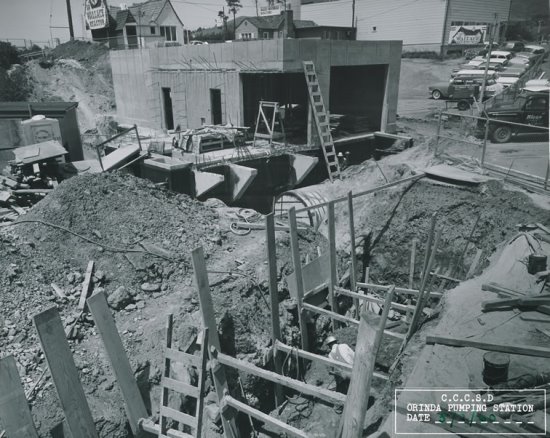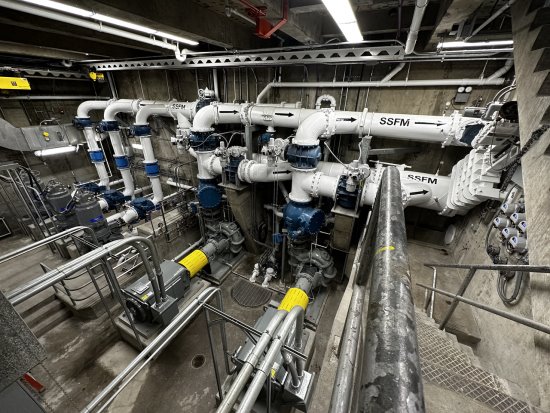| | Published May 10th, 2023
| A clean, well- lighted place for sewage
| | | By Sora O'Doherty |  | | Orinda Pumping Station in 1960 Photo provided |
When you flush your toilet, you might, for a moment, wonder if the Coriolis effect, which says that draining water swirls counter clockwise in the northern hemisphere but clockwise in the southern hemisphere is real (it is), but you probably don't spend much time wondering where the contents of your toilet is going. You're just glad it's gone. But the dedicated engineers at Central Contra Costa Sanitary District have your back, and they recently completed a total revamp of the main Orinda pumping station, located discretely behind Theatre Square.
 This reporter recently enjoyed a tour of the newly refurbished station with Keith Gellerman, a Central San Associate Engineer. Chris Carpenter, Senior Community Affairs Representative, was also on hand. We started at ground level. Through the entry door, there is a small office, which is dominated by large electronic display showing the functioning of the five pumps located below ground. The station is staffed with personnel during normal business hours, but if a problem occurs after that, the electronic controls will automatically call in operators to deal with it right away. Only larger stations are staffed; smaller stations operate automatically.
This reporter recently enjoyed a tour of the newly refurbished station with Keith Gellerman, a Central San Associate Engineer. Chris Carpenter, Senior Community Affairs Representative, was also on hand. We started at ground level. Through the entry door, there is a small office, which is dominated by large electronic display showing the functioning of the five pumps located below ground. The station is staffed with personnel during normal business hours, but if a problem occurs after that, the electronic controls will automatically call in operators to deal with it right away. Only larger stations are staffed; smaller stations operate automatically.
 Central San has 18 pumping stations, and half of those are in Orinda. The need for these stations is caused by the very hilly terrain of the city. Moraga has one, Lafayette doesn't. In many areas, sewage follows the path of gravity, but in Orinda it is necessary to pump it up and over the hills and send it on its way to the sewage treatment plant in Martinez. The station behind Theatre Square is the largest in Orinda. The refurbishment project took two years, and the station was run continuously while all the equipment was replaced.
Central San has 18 pumping stations, and half of those are in Orinda. The need for these stations is caused by the very hilly terrain of the city. Moraga has one, Lafayette doesn't. In many areas, sewage follows the path of gravity, but in Orinda it is necessary to pump it up and over the hills and send it on its way to the sewage treatment plant in Martinez. The station behind Theatre Square is the largest in Orinda. The refurbishment project took two years, and the station was run continuously while all the equipment was replaced.
 The Theatre Square station houses five pumps. Two of the pumps used to operate on diesel, but have been replaced with electric pumps. Three are called "dry weather" pumps. They run about 95% of the time. There are also two larger "wet weather" pumps that kick in when needed to handle even the highest flows that can be caused by storm water seeping in through manhole covers, or joints in the pipes, although the pumps do not handle storm water per se. Some years these large pumps do not run at all. This year, Gellerman says, was a good test for the big pumps, which ran a lot during the heavy winter storms.
The Theatre Square station houses five pumps. Two of the pumps used to operate on diesel, but have been replaced with electric pumps. Three are called "dry weather" pumps. They run about 95% of the time. There are also two larger "wet weather" pumps that kick in when needed to handle even the highest flows that can be caused by storm water seeping in through manhole covers, or joints in the pipes, although the pumps do not handle storm water per se. Some years these large pumps do not run at all. This year, Gellerman says, was a good test for the big pumps, which ran a lot during the heavy winter storms.
 The exterior of the pumping station was built in the late 1950s. The old diesel engines, which also dated from the '50s, were very loud and polluting. The new electric pumps, which operate with a generator backup, are not just on/off pumps, but operate with variable frequency drives. They ramp up or down as needed. Although they run continuously, they run at lower capacity during the night. Usually only one pump is running, and they rotate which pump about once a week. The pumps are housed on the lower level of the station, well below ground.
The exterior of the pumping station was built in the late 1950s. The old diesel engines, which also dated from the '50s, were very loud and polluting. The new electric pumps, which operate with a generator backup, are not just on/off pumps, but operate with variable frequency drives. They ramp up or down as needed. Although they run continuously, they run at lower capacity during the night. Usually only one pump is running, and they rotate which pump about once a week. The pumps are housed on the lower level of the station, well below ground.
 The station has air filters that filter out the gasses, such as hydrogen sulfide, ammonia, carbon dioxide, methane, nitrogen, and hydrogen, so the air smells clean. The station is also air conditioned for the comfort of the staff. Beyond the office there is a large room, lit by skylights.
The station has air filters that filter out the gasses, such as hydrogen sulfide, ammonia, carbon dioxide, methane, nitrogen, and hydrogen, so the air smells clean. The station is also air conditioned for the comfort of the staff. Beyond the office there is a large room, lit by skylights.
 Funding for the renovation is cash-based from user fees. Central San received a $100 million federal loan for treatment plant upgrades. Carpenter says that they try to strike a balance between bonds and current user fees to balance who pays: current users or future users, to maintain the facilities, which include 1,500 miles of pipeline. Generally, about 6 miles of pipes are replaced each year.
Funding for the renovation is cash-based from user fees. Central San received a $100 million federal loan for treatment plant upgrades. Carpenter says that they try to strike a balance between bonds and current user fees to balance who pays: current users or future users, to maintain the facilities, which include 1,500 miles of pipeline. Generally, about 6 miles of pipes are replaced each year.
 A new 900-kilowatt generator is included with this upgrade and powers the pumps in the event of an electrical power outage. The generator is powered by diesel, but meets very stringent air quality controls to limit emissions.
A new 900-kilowatt generator is included with this upgrade and powers the pumps in the event of an electrical power outage. The generator is powered by diesel, but meets very stringent air quality controls to limit emissions. |
 | | The newly refurbished Orinda main pumping station behind Theatre Square pumps Orinda sewage up and over the hill and out to the treatment plant in Martinez. Photo Sora O'Doherty | | | | | | | | | | | |




